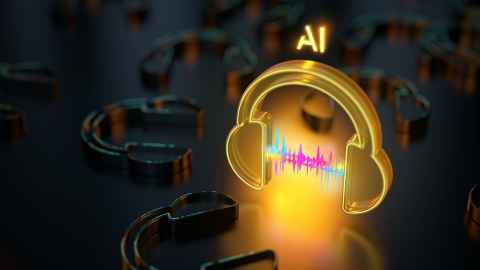Have you listened to the Velvet Sundown?
11 July 2025
Opinion: AI-generated music is raising big questions about copyright, creativity, and what it means to be an artist in the age of AI, writes Joshua Yuvaraj.

Opinion: What’s on your Spotify playlist today? You might have a range of pop anthems, R&B, and maybe a sprinkling of 90s alternative. You might even have had a new band called The Velvet Sundown pop up on a “Discover” playlist.
It may come as a surprise that The Velvet Sundown’s Sufjan Stevens-esque Britpop stylings are (at least in part) AI-generated, as are the band members and its promotional art – though in hindsight the description of “free-spirited percussionist Orion ‘Rio’ Del Mar” on their Spotify profile should be a definite giveaway.
Despite accruing over 675,000 listens to its music at the time of writing, a spokesperson confirmed the band is an “art hoax” – a sort of cultural critique of the difficulties people have at distinguishing the real and the fake.
The first thing to say is that this is permitted. Spotify, unlike some other streaming platforms, doesn’t have any AI music-specific policies on its website. And while the band’s spokesperson was not clear as to how much music was generated using AI music platform Suno, they said it was done for “marketing” and “trolling” purposes.
However, the fact that an AI band can “succeed” like this raises uncomfortable questions about the role of AI-generated art, music and writing and its impact on creators and the public.
For creators, book, music and other markets might be diluted by the avalanche of AI-generated content, diverting consumer income from streaming and purchases that might otherwise go to what we would regard as conventionally human-produced content.
A California lawsuit, brought by a group of writers against Meta, recently failed because the authors – who argued that Meta unlawfully used copies of their books to train its AI model – couldn’t prove they would suffer economic harm. Might it be different as AI-generated works become increasingly indistinguishable from human-generated works?

There’s also the question of whether, and how, the law should allow these works to be monetised. In many countries, copyright law requires human authorship, which means that AI-generated works – at least to the extent humans haven’t contributed – aren’t subject to copyright protection.
New Zealand is one of the few countries which protects works “generated by computer in circumstances where there is no human author”. It’s unclear whether this covers AI – the clause was taken from 1980s UK copyright law, and the UK Government itself is looking to remove that provision for its lack of clarity and use.
A lack of copyright protection for AI-generated works could work in favour of businesses, who would suddenly have a much cheaper selection of music, art and writing to use in advertising than if they had to pay to licence that content. But if copyright law did protect songs like The Velvet Sundown’s, who should benefit? Should the creator of the AI band be entitled to what could be significant income from streaming, licensing, and advertising – bearing in mind there is no need to pay for music gear, touring fees, or production engineers? Should the AI company be able to claim some or all of these profits? Who, ultimately, is the “author” of these songs?
How do we define what’s real and what is not when the lines between AI and human writing, music and art are becoming increasingly blurry? What is the impact of AI-generated work on the way we and our children think? And in making creativity relatively “easier” to achieve, will AI remove the “artistic struggle” (as Australian musician Nick Cave lamented), making it more difficult for people to produce the transformational creativity we need to advance culture and knowledge?
There are no easy answers to these questions. What’s clear, though, is that AI is not going away, and that the impact for creators and the public are likely to be significant.
There is some hope, though, in the Government’s long-stalled Copyright Act Review. When it is resumed, that review presents a unique opportunity for New Zealand to craft world-leading copyright policy for the AI age.
To do so, we need to stop thinking about AI, and first reframe how we think about ourselves. We need to understand what is truly valuable about human creativity, particularly given our unique need to uphold te ao Māori and tikanga Māori.
For example, we might want to understand how human creativity uniquely reflects our emotions; is tied to our moral core; and is birthed in our communities. When we understand these and other elements of human creativity, we can build policy that champions creators, serves the public and encourages the wise, balanced use of new technologies to advance culture and knowledge.
In the meantime, I might just be that much more careful when the newest song pops up on my Spotify feed – even though my head instinctively bobs when I listen to the dulcet tones of The Velvet Sundown’s “singer and mellotron player Gabe Farrow”.
This article reflects the opinion of the author and not necessarily the views of Waipapa Taumata Rau University of Auckland.
This article was first published by Stuff.
Media contact:
Sophie Boladeras, media adviser
M: 022 4600 388
E: sophie.boladeras@auckland.ac.nz